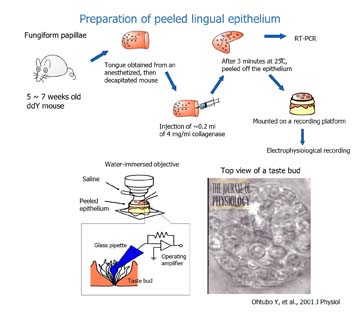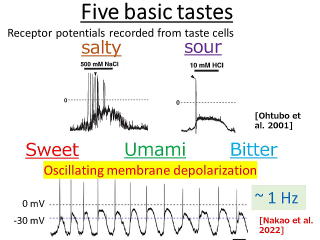Kyushu Institute of Technology
Contact:otsubo@brain.kyutech.ac.jp
Research
We investigate the neuronal basis of chemical sensing, particularly taste
sensing mechanisms, using electrophysiological recordings (patch clamp
recordings), Ca2+ imaging, immunohistostaining, and molecular biological methods.
Preparation of the peeled lingual epithelium
| Taste receptors are expressed on the apical membrane of taste receptor
cells and exposed to a harsh environment, characterized by drastic changes
in osmotic pressure or pH. In contrast, the basolateral membranes of taste
receptor cells face stable physiological conditions. Hence, maintaining
their physiological environment is essential to investigate the signal
transduction mechanisms of taste. Our colleagues developed an in-situ patch
clamping system on which the peeled epithelia containing the taste buds
is set up using an originally developed platform consisting of a barrel
with tubes for irrigating solutions on the apical membrane. The peeled
epithelia are placed on the top of the barrel just like a tympanum. This
way, we can separately irrigate inside (receptor membrane side) and outside
(basolateral membrane sides) the barrel, as the peeled epithelia acts as
a barrier preventing diffusion of taste substances from the apical to the
basolateral membranes of taste receptor cells. |
 |
Taste signal transduction (Oscillating receptor potentials)
| Taste receptor cells (type II cells) are equipped with G-protein coupled taste receptors for sweet, umami, and bitter tastes substances, which generate oscillating membrane potentials according to taste concentration. In contrast, a sour taste substance, HCl, induces membrane depolarization with action potentials in type III taste receptor cells. Interestingly, a salty substance, NaCl (1 M) induces either oscillating membrane depolarization or depolarization. However, it is unclear how and why does taste receptor cells generate these oscillations. In addition, we are interested in understanding why taste receptor cells generate two different receptor potentials in response to salty substances. Furthermore, we want to understand the type of receptor potentials generated by fatty acid substances, what is their modulatory role in the oscillation, etc. |
 |
Techniques
|
Otsubo labOtsubo LAB. Graduate School of Life Science and Systems Engineering, Kyushu Institute of Technology
Hibikino 2-4, Wakamatsu-ku,
Kitakyushu, 808-0196, Japan
email: otsubo@brain.kyutech.ac.jp